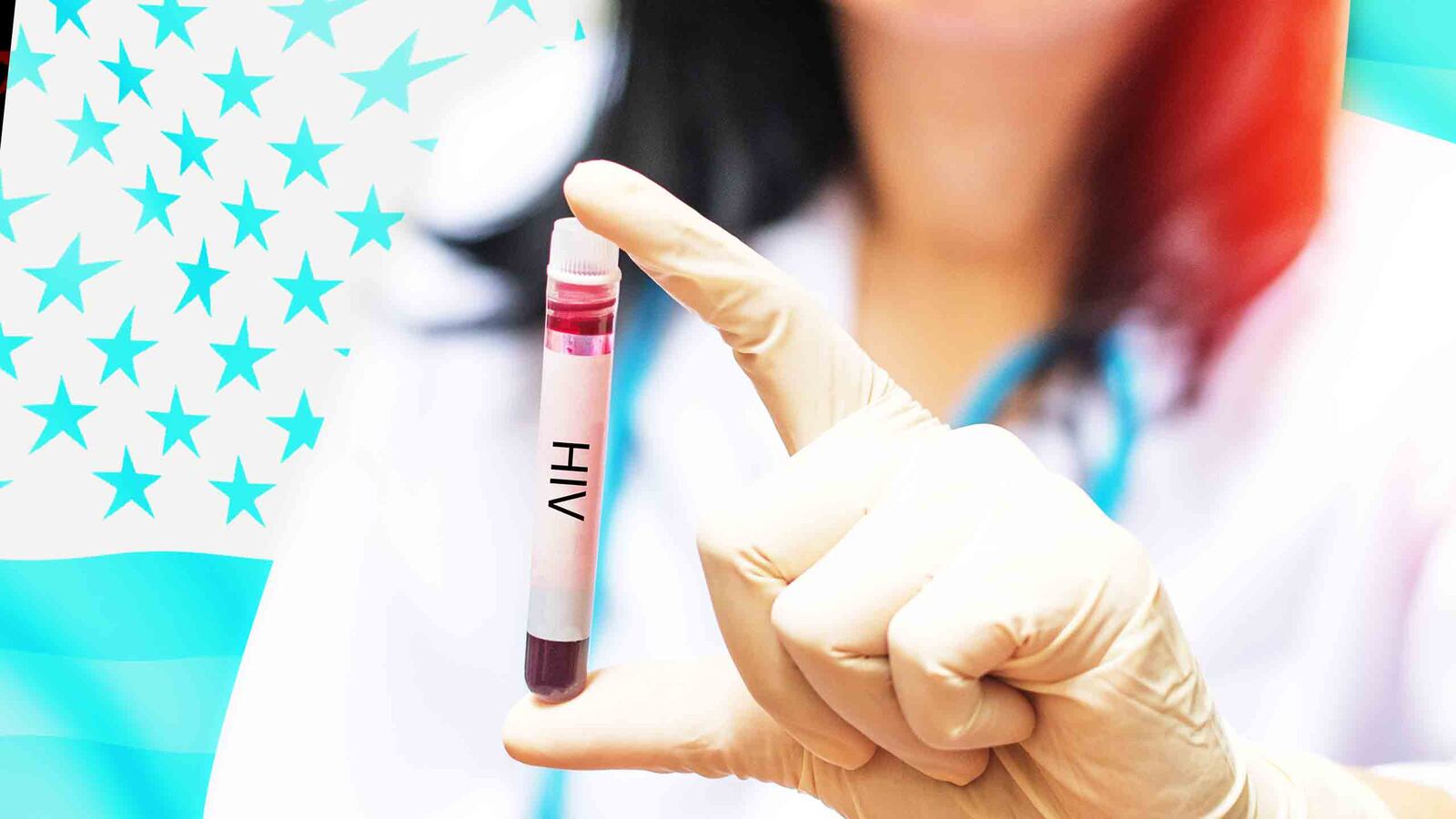“STDs are like the Harvey Weinstein of public health crises,” says Chad Felix Greene, who became HIV positive a decade ago when a partner purposefully transmitted the virus—and who this week, raged on Twitter about California’s new adoption of #HIVIsNotACrime legislation, which reduces knowing transmission from felony to misdemeanor (even in cases of blood bank donation). “Think of it this way: Everyone in this country knows how bad the STD epidemic has gotten, but no one wants to face up to all these difficult conversations we need to have in order to fight the problem.”
Indeed, nationwide, public health experts issued an urgent siren call in the wake of the CDC’s annual Sexually Transmitted Disease Surveillance Report, which revealed yet another rise (the third year in a row now) in the Big Three of tracked STDs in America: chlamydia (1.59 million new cases), gonorrhea (468,514 new cases), syphilis (27,814 new cases, with a tragic 628 cases of congenital syphilis). While HIV rates, tracked separately, reveal a decline nationwide, in several cities around the country such as Miami, Atlanta, New Orleans and San Antonio, Texas, transmissions continue to rise at startling rates. (In Bexar County, Texas, for instance, HIV infections jumped by more than 50 percent in the last decade, from 234 in 2006 to 360 in 2016).
San Antonio’s Mayor Ron Nirenberg announced this week at an HIV summit: “Everyone, and that means everyone, needs to follow the CDC’s recommendations and get tested at least once in their lifetime.”
If only President Trump would follow suit in advocacy—and more importantly, funding.
If ever there was a POTUS who would understand the gravitas of fighting sexually transmitted diseases—and the epidemic our country now faces—it ought to be this one. Don’t forget that in 1997, Donald Trump infamously joked to Howard Stern that he deserved the “Congressional Medal of Honor” for his bravery in avoiding sex with so many loose and willing STD-riddled women in an ordeal he called “my Vietnam.”
But instead, the unfolding STD health travesty provoked the opposite response from our commander-in-chief. In what would be a devastating cut, POTUS proposed a 17 percent reduction in CDC federal STD funding nationwide.
If this course is not reversed, public health experts warn, one of Trump’s legacies could be what public health officials call an “unconscionable” epidemic of STDs that continues to spiral out as the infrastructure to fight the spread breaks down. What would that look like? Billions in health care costs and tragic public health consequences such as a rampage of STD-caused infertility. For all the lobbing about of The Handmaiden’s Tale in pop culture these days, this is one epidemic where the analogy really does fit: Although many women don’t realize it, rising STDs directly correlate as a leading cause of infertility in women.
“We now have rates of babies being born with congenital syphilis not seen in decades,” says David Harvey, executive director of the National Coalition of STD Directors. “It’s a crime. It’s a failure of our health care system. The costs down the road of treating these conditions are enormous with estimates in the billions. STD rates will continue to increase in the United States absent some dramatic change in how we confront these epidemics. Period.”
In multiple interviews with public health advocates tracking the nationwide rise of STDs, their message was united and clear: If President Trump wants to address this public health emergency, our country needs to return to levels of STD-prevention funding once prioritized in the 1990s, when the United States came extremely close to eradicating syphilis completely.
How much is required to turn back the tide? $40 million in the next budget to kick-start the process in 2018.
Simply put: If the STD-prevention infrastructure continues to be gutted, eventually, there will be no going back.
“Women living in inner-city Washington, D.C., have about the same HIV incidence risk as women living in Botswana,” says Barbara Van Der Pol, the incoming president of the American STD Association. “There are STDs out there increasing that risk four- to five-fold that would cost us less than a dollar to treat. Why aren’t we testing? Because the STD-specific clinics are going away.”
In fact, 52 percent of STD prevention clinics have experienced budget cuts.
“I can show you a chart that I took with me when I was on the Hill last week that shows as funding decreases, STDs increase,” Van Der Pol says. “It’s so overwhelmingly consistent. When the money was there, you see the rates going down, down, down. The money goes away, you see rates going up, up, up.”
Ironically, one year after Trump gave his rollicking interview about dodging the "sniper fire" of communicable sexual diseases to a shock-jock, the US hit its historic low of syphilis rates in 1998, with 6,993 total cases nationwide. The next year, the CDC released its historic plan to finally, once and for all, eradicate the centuries-old scourge of syphilis from the United States entirely. (In some cities, like Seattle, health officials went so far as to say that it had been “eliminated.")
Now, with funding for STD prevention being slashed, the 1999 National Plan to Eliminate Syphilis From the United States is an utterly depressing read of how far off course we’ve gone.
At the time, then-CDC director Dr. Jeffrey Koplan told the New York Times: “The stars are aligned for us to get this done. For a modern, industrialized wealthy nation to tolerate the continued transmission of this disease should be unacceptable. We don’t have to have it here.”
And yet here we are.
“It is unconscionable that in the last several years that STD control programs around the country, city and state level have been emasculated in terms of the resources that we have,” says Dr. Hunter Handsfield, a consulting advisor for the American Sexual Health Association who has studied the issue since the 1970s. “That is clearly contributing to the rise.”
Which is why dramatically more discussion of every issue surrounding STD prevention needs to occur. Indeed, while controversy surrounds California’s decision to decriminalize the transmission of HIV from a felony to a misdemeanor, the emerging conversation is helping people understand why many public health officials and activist groups pushed for the law’s passage in the first place. Namely, the theory that less stigma (and fear of facing felony charges) will encourage more people to get tested and be open about their status.
Transparency on social dating sites and apps play into this openness as well. The National Coalition of STD Directors is advocating increased sexual health resources within these apps. As much as it might seem like a bad pun on the virality of “apps,” there does appear to be some reality to the Hookup App Effect. In 2013, an NYU study linked Craigslist to a 16 percent rise in HIV cases between 1999 and 2008.
In every aspect of STDs, attention and communication is urged. For example, recent studies have shown how individuals who are taking PrEP, which can reduce the chances of getting HIV during sex, may be at risk for testing positive for another STD. Last year, the National Coalition of STD Directors spoke out to the CDC to change their guidelines to encourage STD screenings for individuals taking PrEP to occur every three months.
In the face of overwhelming data, if all of this doesn't inspire a call to arms, consider this factor: The United States is now seeing cases of gonorrhea for which all known treatments are beginning to fail.
“We initially thought, ‘Well it’s not going to come over here,’” says Dr. Michael Angarone, assistant professor of infectious diseases at Northwestern University Feinberg School of Medicine. “’It’s going to be a problem in other places, not the United States. And then we started seeing it here. And that’s what happens with drug-resistant bacteria. So not only do you have this issue where we’re seeing more cases of infection, now we’re starting to see and get concerned about growing resistance to the treatment that we have.”
Without vigilance in naming this STD epidemic as the critical turning point that it is, young people and marginalized communities will continue to be the hardest hit. Why? Because the trend of sex being a trend is never not going to trend.
“People are primarily motivated to have sex because it feels good,” says Michael Vigorito, a certified sex therapist with the American Association of Sexuality Educators, Counselors and Therapists. “Most people are also motivated to not get a disease. But at times, their short-term motivation for sexual pleasure is stronger than their long-term goal of avoiding sexual diseases. We can help them achieve both if we talk about both.”
But for as much as public health experts overwhelmingly advocate a reduction of shame regarding discussion of STDs, there is one exception.
Maybe it is time for our government to finally feel the embarrassment of what neglecting this problem has done to our nation’s sexual health—especially in comparison to our international neighbors. Take Cuba for example. WHO confirmed in 2015 that the country has completely eliminated the transmission of syphilis and HIV from mothers to babies. Meanwhile, the United States is dealing with heartbreaking levels of congenital syphilis in newborns, whose chances of surviving are often grim.
“Cuba plainly and simply decided that it was important to them, and they would make the effort to make sure that they test every pregnant woman for syphilis and HIV,” Van Der Pol says. “The fact that we have congenital syphilis cases in the United States, it’s an indictment of the health care delivery system.”
But the indictment stops there.
Because on a societal level, one of the seemingly never-ending challenges in tackling STDs is simply addressing the disparate and often gendered “shaming” reactions to STD or sexual stigma in play.
“Unlike for men, for women, there’s this idea that ‘you did something wrong, you had too many partners, you weren’t a good girl,’” Van Der Pol says. “I just cringe when I hear that.”
As with Trump who was egged on by Stern in his recounting of his “heroism” in outsmarting STDs, men are often held to a different standard of accountability. Look at Usher’s widely publicized $20 million lawsuit by Laura Helm (one of several individuals who are suing the singer alleging he gave them herpes), where the reaction has been typically forgiving of him—and shaming of the central woman involved.
“Whenever something egregious happens, the reaction is very telling,” Van Der Pol says. “It’s like, ‘It’s been a bad week for Harvey Weinstein.’ But the response is: It’s been a bad eternity for women.”






